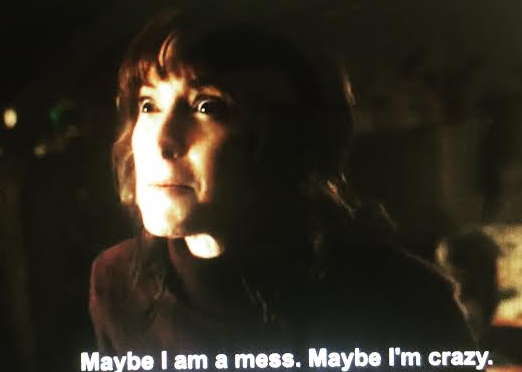Channeling two of her best characters, Lelaina Pierce and Susanna Kaysen, Winona Ryder takes on the role of Joyce Byers in Stranger Things with a level of intensity she has never showcased before (not even during her brief stint as Beth MacIntyre as the usurped ballet star in Black Swan). But it’s more than the fact that lines Lelaina or Susanna herself has said, including the emotionally tinged “Go to hell” (which Lelaina says stoically on the verge of tears to Troy [Ethan Hawke] in Reality Bites), are repackaged and repurposed by Ryder. It’s that she has finally come into her own as an actress, in a way that, in her “youth” she was not always able to, in large part thanks to being billed as a kitsch anomaly–the original Christina Ricci, if you will.
Created by the Duffer Brothers, known singly as Matt Duffer and Ross Duffer, Stranger Things is that rare breed of show that pays homage to everything you love about the 80s while also carefully crafting its own identity. Based in a small Indiana town called Hawkins, one gets the sense that the Duffer Brothers have been studying the source materials required to create this narrative since their childhood spent in Durham, North Carolina. And, as maybe identical twins both aged thirty-two, one knows that they didn’t exactly come of age during the era that has so inspired the chapters of this hybrid love letter to Steven Spielberg, Ridley Scott, Stephen King and John Carpenter. That being said, the casting of Ryder, an 80s staple herself with films like Beetlejuice and Heathers, adds an extra layer of authenticity to the feel of the show. Matthew Modine, too, in the role of creepy Dr. Martin Brenner enhances the illusion of being one with the decade, considering his “80s heartthrob” status reached its peak with 1985’s Vision Quest (objectively most notable for including Madonna’s “Crazy For You” on its soundtrack).
Starting from its, well, The Neon Demon-esque title intro (originally helmed by the title designs of Richard Greenberg), Stranger Things establishes a chapter format (something another lover of the homage, Quentin Tarantino, favors as well) that begins on November 6, 1983 with “The Disappearance of Will Byers.” Highlighting the nerd culture of Dungeons and Dragons at that time (also enjoyed by Judd Apatow in Freaks and Geeks), the Duffer Brothers effortlessly showcase the rapport between four small-town friends, Will (Noah Schnapp), Mike Wheeler (Finn Wolfhard), Dustin Henderson (Gaten Matarazzo) and Lucas Sinclair (Caleb McLaughlin). When Will leaves Mike’s basement after a particularly intense game one night, however, he is seemingly abducted by an ominous presence we later come to know as “the monster.”
With each episode, the Duffer Brothers’ apparent encyclopedic knowledge of 80s pop culture suffuses the screen. Certain scenes offer even subtler nods, like the one in Chapter 5, “The Flea and the Acrobat,” when Joyce is forced to have a funeral for Will even though she knows he’s still alive, and the soundtrack to the beginning of the episode consists of the same New Order song that plays when Blaine and Steff ignore Andie in Pretty In Pink. And while, yes, many of the references tend to be toward early 80s pastiche, there are a handful of late 80s traces that make the cut as well. For instance, 1986’s The Manhattan Project in which a similar secretive government building just out of town plays an integral role to the plot and 1987’s Predator, featuring a creature with a similar aesthetic and modus operandi.
In Chapter 2: “The Weirdo on Maple Street,” Mike, Dustin and Lucas’ discovery of Eleven a.k.a. El (Millie Bobby Brown) in the woods they call Mirkwood (in honor of Lord of the Rings) prompt the minutest of allusions to intensify, with Dustin suggesting that she escaped from a nearby mental institution–just like Michael Meyers in John Carpenter’s Halloween.
But more than how thoroughly researched the show is (even with regard to the MKUltra element), there is Winona, who has gradually been crawling out of the career hole she dug for herself in 2002, not just by shoplifting from Saks Fifth Avenue, but by choosing to star in Mr. Deeds. Sure, she’s had her flickers of re-emergence here and there with respectable film choices like The Iceman and Experimenter, but, by and large, Ryder hasn’t been able to carry a project in a starring role since the pre-shame era of Girl, Interrupted. And this, of course, brings one to the similarities of Joyce Byers and Susanna Kaysen in terms of outsiders’ perception of each character’s mental stability. Joyce’s insistence on the fact that Will is still alive leads essentially everyone in town to proffer that she’s going insane from the grief. Even her own son, Jonathan (Charlie Heaton), is perhaps the most skeptical of her theory that Will is communicating with her through the lights. She also has to defend herself to her opportunistic deadbeat ex-husband, Lonnie (Ross Partridge), screaming, “Maybe I am a mess. Maybe I’m crazy. Maybe I’m out of my mind!” But as Ryder can tell you, hints of lunacy can be a boon to one’s success.






















